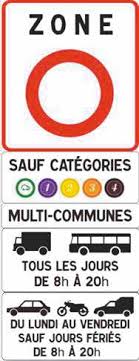The objectives of the LOM Law, the quotas for clean vehicles in fleet renewals, the installation of charging stations, the Business Mobility Plan, the sustainable mobility package, the mobility permit and the ZFE-m, you will know everything on the LOM Law!
The objectives of the LOM 2022 law
The Mobility Orientation Law (or LOM) consists of initiating a profound transformation in the daily mobility of all citizens. This translates into more efficient, cleaner and more accessible transport solutions.
Concretely, speaking of company automobile fleets, the objectives of the LOM are as follows:
- Gradually reduce the use of polluting vehicles by replacing them with cleaner vehicles
- Facilitate home-work journeys by reducing dependence on individual car use
- Encourage travel by bike, scooter, on foot or by carpooling with a bonus of up to €600/year (Sustainable mobility package, mobility voucher )
The Climate and Resilience Law ( published in the Official Journal on August 24, 2021 ) has tightened the LOM on clean vehicle quotas.
As a reminder, the mobility orientation law was published in the Official Journal on December 26, 2019 . This law profoundly transforms mobility policy, with a simple objective: everyday transport that is easier, less expensive and cleaner.
Clean vehicle quotas for companies with more than 100 vehicles
The text specifies that the companies concerned are “ companies which directly or indirectly manage, as part of their activities in the competitive sector, a fleet of more than 100 motor vehicles whose total authorized weight is less than or equal to 3.5 tons . »
The size of the fleet (>100 vehicles) to be considered is that of all the establishments established in France and the subsidiaries established in France of the company.
There are currently no sanctions for non-compliance with this rule.
- 2022: 10% low-emission engines* in corporate car fleet renewals
- 2024: 20% OF LOW EMISSION* ENGINES IN CORPORATE AUTO FLEET RENEWALS
- 2027: 40% OF LOW EMISSION ENGINES* IN CORPORATE AUTO FLEET RENEWALS
- 2030: 70% OF LOW EMISSION MOTORIZATION* IN CORPORATE AUTO FLEET RENEWALS
- 2035: COMPLETE DISAPPEARANCE OF THERMAL ENGINES IN VEHICLE SALES
Know the obligations for public actors
According to article L224-8 and for vehicles with a total loaded weight of ≤3.5 t:
Concerning the State and its public establishments which manage (directly or indirectly) a fleet of more than 20 vehicles for activities not belonging to the competitive sector:
- 30% of low-emission vehicles* currently
- 50% low-emission vehicles* until December 31, 2026 and 70% from January 1, 2027
- 37.4% of very low emission vehicles** from January 1, 2026 to December 31, 2029
- 45% of very low emission vehicles** from January 1, 2030
Concerning local authorities, their groups and their public establishments which manage (directly or indirectly) a fleet of more than 20 vehicles for activities not belonging to the competitive sector:
- 30% low-emission vehicles* until December 31, 2024,
- 40% low-emission vehicles* from January 1, 2025 to December 31, 2029
- 70% of low-emission vehicles* from January 1, 2030
- 37.4% of very low emission vehicles** from January 1, 2026 to December 31, 2029
- 40% of very low emission vehicles** from January 1, 2030
45% of very low emission vehicles** from January 1, 2030.
Concerning other contracting authorities and contracting entities:
- 40% of low-emission vehicles* from January 1, 2022
- 37.4% of very low emission vehicles** from January 1, 2026 to December 31, 2029
*Low-emission vehicle (VFE) : Passenger car or van whose CO² emissions do not exceed 50 gCO2/km according to Article D224-15-11 of the Environmental Code
**Very low-emission vehicle (VTFE) : Passenger car, van, two- or three-wheeled motor vehicle or motorized quadricycle whose energy source is: electricity (EL), hydrogen (H2), hydrogen-electricity [rechargeable hybrid] ( HEY) ; hydrogen-electricity [non-rechargeable hybrid] (HH) or compressed air (AC) according to Article D224-15-12 of the Environmental Code
Public charging points

100,000 charging points are to be opened to the public in 2022.
As of February 28, 2022, 55,515 were open to the public in France, an increase of 53% over 12 months according to Avere , national association for the development of electric mobility.
By 2030 , the government aims to install 7 million public and private charging points . (currently 612,000)
The installation of charging stations is mandatory in car parks with more than 10 spaces in new or renovated buildings.
In businesses, the pre-equipment and installation of charging stations is mandatory and may concern at least 5 to 10% of parking spaces depending on the number of inhabitants in the urban area. This legal obligation concerns the car parks of tertiary, industrial, public service buildings, commercial complexes and cinemas.
There is also financing assistance for the installation of electric charging stations, whether for individuals, businesses or communities: La Prime Advenir . Companies can thus receive financing of up to 60% of the costs of installing electrical terminals and 80% for the modernization of an existing charging point.
FATEC Group supports companies in identifying vehicles that can be replaced by VFEs and in deploying on-site or at-home charging infrastructure.
Be accompanied
The Employer Mobility Plan
The Employer Mobility Plan (PDME), formerly the Company Travel Plan (PDE), is a real business project promoting the use of alternative modes of transport to the private car, and is governed by the Orientation Law of Mobility (LOM).
The companies concerned by the obligation to implement an Employer Mobility Plan are companies with at least 50 employees on the same site. The law then requires the company concerned to create a mobility diagnosis and then present the action plan deployed.
How to create an Employer Mobility Plan?
The development of the Employer Mobility Plan can take 6 to 12 months during which 4 stages are addressed:
- Diagnosis: Employee travel practices, accessibility conditions and site access
- Action plan: Identify the most relevant actions to deploy, budget, timetable, resources, communication strategy and consultation
- Implementation: Carry out actions, deploy appropriate tools
- Evaluation: Monitor the implementation of actions, evaluate the success of the system and employee satisfaction
The Sustainable Mobility Package

The Sustainable Mobility Package (or FMD) is a system resulting from the Mobility Orientation Law allowing employees to benefit from financial assistance from their employer for their home-work journeys. The Sustainable Mobility Package is often implemented as part of the Employer Mobility Plan.
In 2022, the FMD takes into account journeys:
- by public transport (transport tickets only, no subscription)
- by bike, with or without electric assistance, for purchase or rental
- with self-service scooters
- by scooter and other personal transportation devices (scooter, skateboard, monowheel, gyropod, hoverboard, etc.)
- in carpooling
- in car sharing (with low-emission vehicles)
The tax and social security contribution exemption limit for the FMD is €500/year per employee.
However, it can go up to €600 if the Sustainable Mobility Package is combined with a public transport subscription.
FATEC Group supports companies in developing their mobility plans and implementing the FMD.
Get support for setting up a mobility plan and an FMD
The mobility permit
The mobility voucher is one of the payment methods offered to employees as part of the Sustainable Mobility Package. It is based on the same principle as restaurant vouchers since it constitutes “an easy-to-use payment solution, integrating the sustainable mobility package or employer assistance for fuel costs and for powering electric vehicles , rechargeable hybrids or hydrogen,” specifies the Minister of Transport.
The mobility document is issued in electronic form and is prepaid .
Find out more about the mobility permit
Low Emission Mobility Zones (ZFE-m)

Low Emission Mobility Zones (ZFE-m) were created to protect residents of towns and cities where air pollution is significant. Within the perimeter of an ZFE-m, only the least polluting vehicles (based on their Crit'Air certificate) have the right to circulate. It is the municipalities which set the periods when circulation is restricted, the types of vehicles concerned (cars, heavy goods vehicles, etc.) as well as the minimum Crit'Air level to be able to circulate (possible exceptions, see terms and conditions on the metropolis website directly ).
- Around ten ZFE-m have already been created and implemented in towns with more than 150,000 inhabitants.
- By 2024, it is planned to have a total of 45 ZFE-m in France, still in cities with more than 150,000 inhabitants.
FATEC Group supports companies in their energy transition challenges:
- Employer Mobility Plan
- Sustainable Mobility Package
- Mobility Consulting
- Fleet greening
- Support for the installation of charging stations
Contact us


